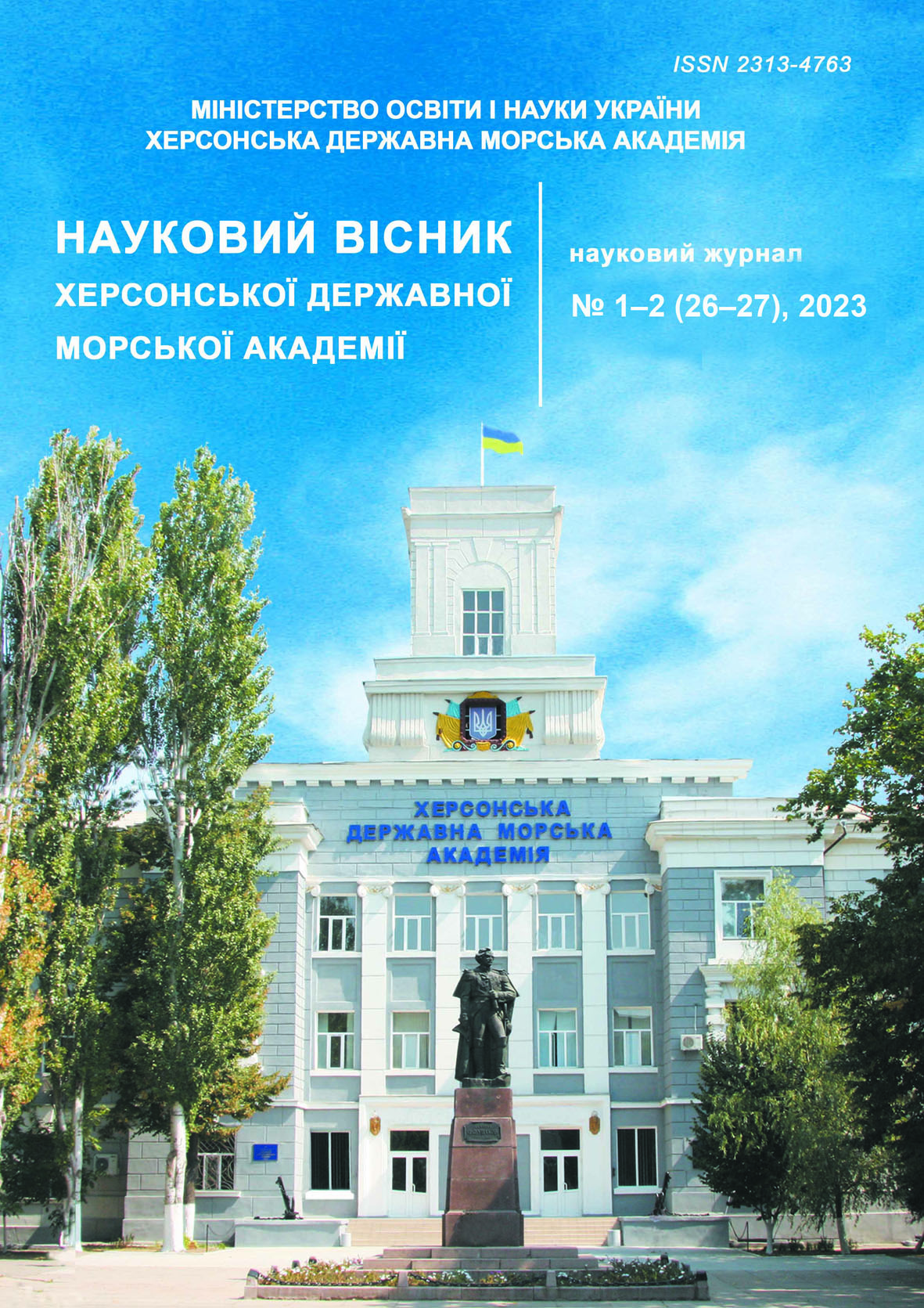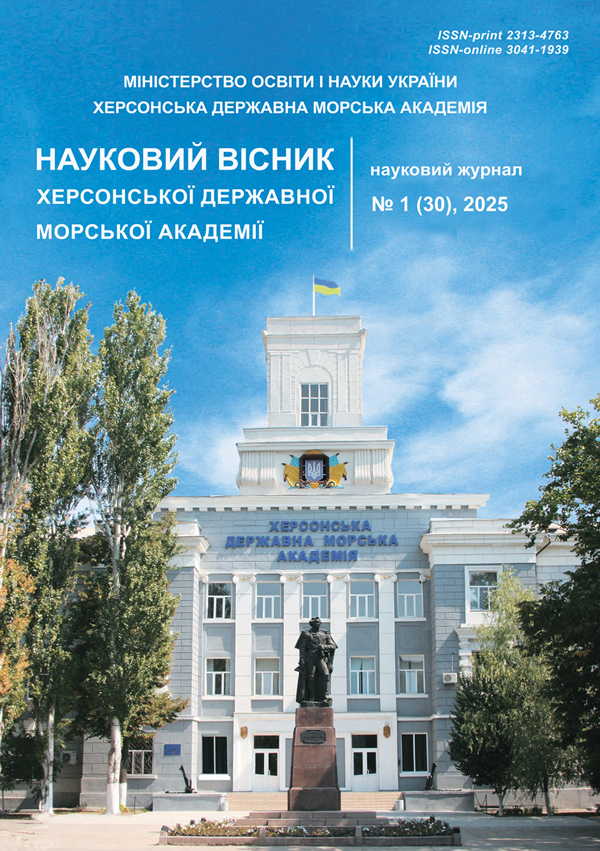AUTOMATIC ADJUSTMENT OF THE DYNAMIC POSITIONING SYSTEM REDUNDANT STRUCTURE BY DETERMINANT
https://doi.org/10.33815/2313-4763.2025.1.30.016-030
Abstract
The object of the study is the dynamic positioning processes of a vessel with two stern azipods and a bow thruster. Automation of motion control processes allows to significantly increase the efficiency of control systems by using modern methods of information processing, including optimization, and is used in many industries: space, aviation, marine, welding production, etc. New opportunities for increasing the efficiency of control systems have appeared with the use of redundant control. Redundant structures of actuators have traditionally been used for redundancy and increasing the reliability of control systems by excluding failed devices from operation. Over time, they have also been used to optimize control processes. In the marine industry, redundant structures have become most widespread in dynamic positioning systems. One of the requirements for such systems is to ensure maximum accuracy of positioning processes, including under the influence of external influences from any direction. According to the authors, this ability of the control system can be ensured by maximum dilution of the control vectors of the structure (maximization of the determinant). The paper developed a method for tuning a redundant structure that provides this possibility. The obtained result is explained by: using the on-board computer in the control system; finding the optimal state of the structure at each step of the on-board computer, which is determined by the maximum determinant, taking into account the constraints of the type of equalities, to create the necessary controls by the structure, and the type of inequalities, to take into account the constraints of the structure on the maximum thrust force and the angle of rotation of the screws; reconfiguring the structure to a certain optimal position. The operability and effectiveness of the method are confirmed by mathematical modeling in the MATLAB environment. The modeling results showed that the reconfiguration of the structure can be carried out against the background of the execution of the main functional tasks, without creating disturbing forces and moments. The obtained results are reproducible and can be used in the design of dynamic positioning systems.
References
2. Zinchenko, S. N., Lyashenko, V. G., Shalaeva, A. A. (2017). Calculation and implementation of the maneuver of divergence from target vessels in the on-board digital computer, Matherials of the 4-st International Scientific and Practical Conference “Safety of life in transport and information technology, science, practice”, Kherson, 14–16 spring 2017, pp. 230–235.
3. Zinchenko, S. N., Lyashenko, V. G. (2017). Using a neural network model of a vessel to solve control problems, Scientific Bulletin of the KhDMA No. 2 (17), pp. 231–237. http://journals.ksma.ks.ua/nvksma/article/view/587/524.
4. Jacobellis, G., Gandhi, F., Floros, M. (2019). Using Control Redundancy for Power and Vibration Reduction on a Coaxial Rotor Helicopter at High Speeds, Journal of the american helicopter society. https://doi.org/10.4050/JAHS.64.032008.
5. Gao, W., Tang, Q., Yao, J., Yang, Y. (2020). Automatic motion planning for complex welding problems by considering angular redundancy, Robotics and Computer-Integrated Manufacturing, https://doi.org/10.1016/j.rcim.2019.101862.
6. Pakaste, R., Laukia, K., Wilhelmson, M., Kuuskoski, J. (1999) Experience with Azipod®propulsion systems on board marine vessels, Marine Propulsion. https://library. e.abb.com/public/2314773146eb2d77c1256ec300341511/12-18%20ENG%209902.pdf.
7. IMCA Marine Division: Guidelines for the design and operation of dynamically positioned vessels. (2019). The International Marine Contractors Association. https://www.imca-int.com/product/guidelines-for-the-design-and-operation-of-dynamically-positioned-vessels/.
8. Zinchenko, S., Kobets, V., Tovstokoryi, O., Nosov, P., Popovych I. (2023). Intelligent System Control of the Vessel Executive Devices Redundant Structure, CEUR Workshop Proceedings, Vol-3403, pp. 582–594. https://ceur-ws.org/Vol-3403/paper44.pdf.
9. Zinchenko, S. N., Lyashenko, V. G., Grosheva, O. A. (2018). Optimal control of redundant azipod structures, Proceedings of the V International Scientific and Practical Conference "Life Safety in Transport and Production: Education, Science, Practice", Kherson, September 13–15, 2018, pp. 78–81.
10. Cherniavskyi, V. V., Zinchenko, S. M., Nosov, P. S. (2021). The use of exsessive actuatos structures in automatic vessel movement control systems, Materials of the III International Maritime Scientific Conference of the ship power plants and technical operation department of odessa national maritime university (MPP&O-2021), Odessa, April 29–30, 2021, p.p. 466–472. https://doi.org/10.13140/RG.2.2.36574.15681.
11. Zinchenko, S. (2020). Study of a minimally excessive complanary control structute with two azimuth control devices, Materials of the VII International Scientific and Practical Conference "Life Safety in Transport and Production: Education, Science, Practice", Kherson, September 9–12, 2020, p. 319–325.
12. Zinchenko, S. M., Nosov, P. S., Mamenko, P. P., Moiseenko, V. S., Mateichuk, V. M., Kyrychenko, K. V., Polishchuk, V. O. (2021). Use of zero movements for adjustment of redundancy structures, Proceedings of the 1st International Scientific and Practical Conference "Problems of Sustainable Development of the Maritime Industry (PSDMI-2021), Kherson: KhDMA, November 3–4, 2021.
13. Santos, M. F., Santos Neto, A. F., Honorio, L., Silva, M. F., Mercorelli, P. (2023). Robust and Optimal Control Designed for Autonomous Surface Vessel Prototypes, IEEE Access, (99):1–1. https://doi.org/10.1109/ACCESS.2023.3239591.
14. Rigatos, G. A. (2022). Nonlinear optimal control approach for underactuated offshore cranes, Ships and Offshore Structures. https://doi.org/10.1080/17445302.2022.2150420.
15. Bao, X., Jiang, C. (2023). Time-Optimal Control Algorithm of Aircraft Maneuver, in book: Advances in Guidance, Navigation and Control. Proceedings of 2022 International Conference on Guidance, Navigation and Control. https://doi.org/10.1007/978-981-19-6613-2_454.
16. Bartels, S., Helling, S., Meurer, T. (2023). Inequality Constrained Optimal Control for Rope-Assisted ASV Docking Maneuvers, IFAC-PapersOnLine, pp. 44–49. https://doi.org/10.1016/j.ifacol.2022.10.407.
17. Leparoux, C., Herisse, B., Jean, F. (2022). Structure of optimal control for planetary landing with control and state constraints, ESAIM Control Optimisation and Calculus of Variations. https://doi.org/10.1051/cocv/2022065.
18. Cheng, X., Deng, S., Cheng, B., Meiqian, L., Zhou, R. (2020). Optimization of bias current coefficient in the fault-tolerance of active magnetic bearings based on the redundant structure parameters, Automatika, 602–613. https://doi.org/10.1080/00051144.2020.1806012.
19. Huang, W., Xu, H., Wang, J., Miao, C., Ren, Y., Wang, L. (2020). Redundancy Management for Fault-tolerant Control System of an Unmanned Underwater Vehicle, 5th International Conference on Automation, Control and Robotics Engineering (CACRE): Proceedings, China, 19–20 Sept. 2020. https://doi.org/10.1109/CACRE50138.2020.9230038.
20. Li, W., Shi, G. (2020). Redundancy management strategy for electro-hydraulic actuators based on intelligent algorithms. Advances in Mechanical Engineering. https://doi.org/10.1177/ 1687814020930455.
21. Piloting Vessels Fitted with Azimuthing Control Devices (ACD’s). (2013). United Kingdom Maritime Pilot’s Association (UKMPA), Transport House, London. https://www.yumpu.com/en/document/view/13677403/piloting-vessels-fitted-with-azimuthing-control-devices-acds.
22. Dakova, S., Wagner, J. L., Gienger, A., Tarín, C., Böhm, M., Sawodny, O. (2021). Reconfiguration Strategy for Fault-Tolerant Control of High-Rise Adaptive Structures, IEEE Robotics and Automation Letters, Vol. 6, Issue: 4, 2021. https://doi.org/10.1109/LRA.2021.3093861.
23. Gulay, T. A., Zakharov, V. V., Kron, R. V., Litvin, D. B., Popova, S. V. (2021). Mathematical model of reconfiguration of the aircraft integrated control system on the basis of embedding systems technology, AIP Conf. Proc., Vol. 2402, Issue 1, 070052. https://doi.org/10.1063/5.0074028.
24. Huang, R., Tang, S., Cai, Zh., Zhao, L. (2025). Robust Self-Reconfiguration for Fault-Tolerant Control of Modular Aerial Robot Systems, https://doi.org/10.48550/arXiv.2503.09376. https://arxiv.org/pdf/2503.09376.
25. Wen, J., Song, Ya., Wang, H., Han, D., Yang, Ch. (2023). Hybrid Adaptive Control for Tiltrotor Aircraft Flight Control Law Reconfiguration, Aerospace 10(12), 1001. https://doi.org/10.3390/aerospace10121001.
26. Hu, G., Li, Ya., Li, X., Zhang, G., Zhang, Zh., Wang, X., Man, W. (2023). Modular self-reconfigurable spacecraft: Development status, key technologies, and application prospect, Acta Astronautica, Vol. 207, P. 240–256, 2023. https://doi.org/10.1016/j.actaastro.2023.03.012.
27. Tan, J., Shang, M., Jin, L. (2024). Metaheuristic-Based RNN for Manipulability Optimization of Redundant Manipulators, IEEE Transactions on Industrial Informatics, Vol. 20, Issue 4, 6489–6498. https://doi.org/10.1109/TII.2023.3348830.
28. Liu, Y., Chen, X., Wu, L., Huang, G., Luo, J., Huang, Yu. (2024). Global optimization of functional redundancy in a 6R robot for smoothing five-axis milling operations, Engineering Optimization Vol. 56, Issue 1, pp. 138–154. https://doi.org/10.1080/0305215X.2022.2147519.
29. Gritsuk, I., Nosov, P., Bondarchuk, A., Bondarchuk, O. (2023). Using redundant control to optimize control torque, Technology audit and production reserves 3(2(71)):20–24, https://doi.org/10.15587/2706-5448.2023.282042.






